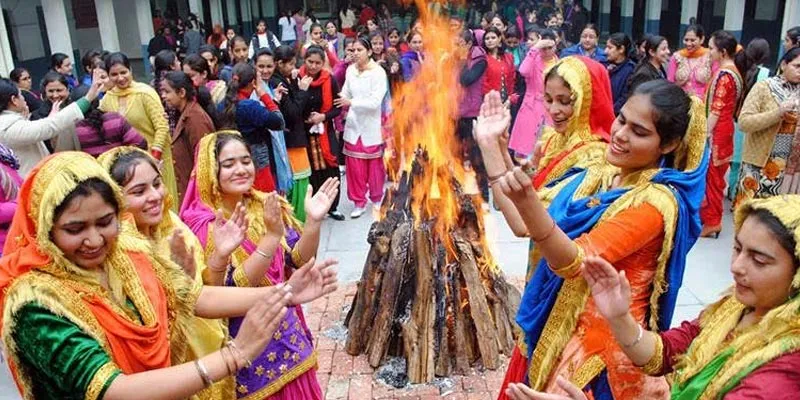How the harvest festival represents diverse colours and scents of India
Be it the sakkarai pongal from Tamil Nadu or Lohri’s rewari and gajak from Punjab and Haryana, seasonal harvest festivals highlight the diversity of India.

It is again that time of year when we celebrate the bountiful harvest.
As we embark on a new year with promises to eat right and become fit, the aromas of spices from some delicious dishes lull us into forgoing our resolutions — just this once— and losing ourselves in the celebrations of our farmers.
While across Northern India the celebrations are marked under the collectiveMakar Sankranti, the festival varies with geography— each with a unique tradition, story, and food. These variations, however, serve as a reminder of the bounties of nature and the importance of preserving natural resources at a time when we are battling global warming.
Lohri: Punjab and Haryana
The mere mention of Punjab and Haryana’s Lohri brings forth images of men and women dressed in colourful salwar kameez as the sounds of nagara (drums) fill the air.

Celebrated on the eve of Makar Sankranti by both the Hindus and the Sikh community, this festival marks the end of winter and of the sowing season of the rabi crop, now ready to be harvested. The festival is marked by paying reverence to Surya or the Sun God, and farmers hope that the coming season will prove to be bountiful for them.
Friends and family come together every year on January 13 to light bonfires as a homage to the Fire God, Agni, and dance to traditional music while snacking on delicious seasonal foods —
sweets like gajak made of sesame seeds and groundnuts bound together with sugary syrup; cakes of peanuts, puffed rice, and gur (jaggery) in the delicious form of chikki; peanuts; and popcorn.
All this is accompanied by the traditional meal of the aromatic sarson ka saag and makki ki roti.
Kicheri: Uttar Pradesh
The harvest in Uttar Pradesh is marked by a holy dip in the Ganges. Over two million people gather across the holy river and perform rituals and bathe in the water early in the morning while fasting.

Following this, the public indulge in sweets with til and gur ladoo (sesame and jaggery sweet). People partake in singing songs and everyone makes a point of wearing new clothes.
The public donates generous portions of black lentils and rice, along with sesame and jaggery, to the needy.
The aroma of black lentil khichdi wafts across the streets in any part of Uttar Pradesh. In fact, the celebrations are also known as Kicheri locally.
Poush Sankranti: Bengal
Celebrated as Poush Sankranti, the Bengali version of the harvest festival has the kitchen or the rannaghar at the centre. The three-day festivities involve the worship of Goddess Lakshmi. Family and friends gather around the kitchen as the preparation of delicious goodies is underway.

Freshly harvested paddy along with the date palm syrup in the form of khejurer gur is used in the preparation of a variety of traditional Bengali sweets.
Rice flour, coconut, milk, and 'khejurer gur' is mixed together to form the sweet and much-sought-after ‘pitha’, a Bengali version of the crepe.
Bhogali Bihu: Assam
Food and enjoyment are an important part of the harvest festival in Assam too. Community festivities are central to this region where people get together around the bonfire, known as meji, and then feast together.

Using sesame, coconut, jaggery, and rice flour, people make a variety of rice fritters, known as pitha — til pitha, narikel pitha, ghila pitha. This forms the main attraction in the feast.
Other preparations include a lavish banquet of lentils, fish, duck, varieties of meat like pork, chicken, and mutton, and a mash made of roasted sweet potato and rice.
Offering prayers to Agni, people throw pithas and betel nuts in the meji. The night-long celebration is marked by singing Bihu songs, beating of the dhol, and indulging in sports.
Uttarayan: Gujarat
Colourful kites of all sizes and shapes take over the skies over Gujarat as revellers indulge in quite-serious kite battles with neighbours. This unique tradition is observed in the state with much pomp and people start preparing for the event weeks in advance. The shops are filled with a variety of kites with a different theme each year.

Gujaratis also indulge in a variety of delicacies ranging from jalebi, chikki, savoury mixtures, dhokla, and khichdi.
The main attraction is reserved for undhiyu puri, made from green beans, potatoes, sweet potatoes, yam and eggplant; the mix is then lathered with a mix of local spices and sesame oil, and cooked the traditional way in an earthen pot.
Pongal: Tamil Nadu
The most popular and revered festival of Tamil Nadu is Pongal. The four-day festivities are observed in the month of ‘Thai’, to mark the sun's transition northwards for a six-month period.
The tradition of Pongal dates back almost 1,000 years to the Chola empire. The word ‘Thai Pongal’ literally means ‘to boil’, signifying an overflow of the harvested crops. Hence, this festival is marked with the cooking of rice porridge or pongal.

Typically rice, cereals, sugarcane and turmeric are used in the preparation of the feast. The rice is made to boil until it overflows, symbolising abundance and prosperity.
The festival is also marked by paying reverence to nature— including the Sun God, Angi and Lord Indra for rain— and cattle, which is essential for the farming community.
Bhogi: Andhra Pradesh
Kites, rangoli, decorated bulls, and traditional Haridasulu songs are features of the three-day long festivities.

In a unique tradition, Andhra Pradesh celebrates the three-day festival with a bonfire where old and worn-out household items like brooms, winnow, and other flammable articles are used for burning. As the flames die down, people heat vessels of water, which is then used to wash the hair. This is meant to wash away the bad luck of the year that passed.
In sum
India’s rich traditions and festivals have been passed down generations, with each one serving as a reminder of nature’s bounties and the very essence of livelihood — food and agriculture.







